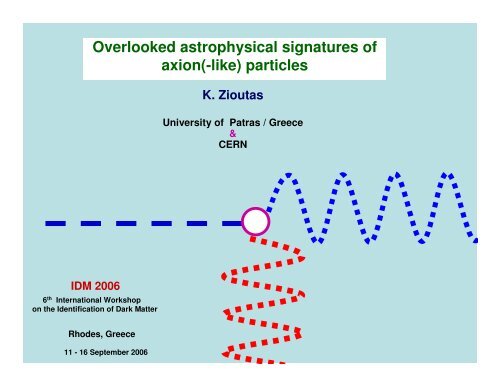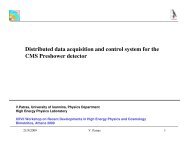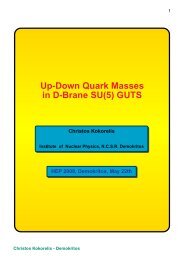Overlooked astrophysical signatures of axion(-like) particles
Overlooked astrophysical signatures of axion(-like) particles
Overlooked astrophysical signatures of axion(-like) particles
You also want an ePaper? Increase the reach of your titles
YUMPU automatically turns print PDFs into web optimized ePapers that Google loves.
<strong>Overlooked</strong> <strong>astrophysical</strong> <strong>signatures</strong> <strong>of</strong><strong>axion</strong>(-<strong>like</strong>) <strong>particles</strong>K. ZioutasUniversity <strong>of</strong> Patras / Greece&CERNIDM 20066 th International Workshopon the Identification <strong>of</strong> Dark MatterRhodes, Greece11 - 16 September 2006
The solar (stellar) <strong>axion</strong> paradigm Escaping energy: star evolution [=age] limits on g aγγ no direct <strong>axion</strong> signal [as yet] <strong>axion</strong>s = invisible PVLAS more?“natural” fine tuning + high efficiency unexplained solar/stellar observations! <strong>axion</strong>s ≠ invisibleThe extended <strong>axion</strong> paradigm this work …
How can ~<strong>axion</strong>s show-up in celestial obs’s?Properties γ×B
Challenging questions @ Sun 11 years cycle!? Solar corona heating Flares instantaneous particle acceleration Dynamo(s) B ⊙ Sunspots heating Neon composition “Solar Model problem”! » smoking-gun <strong>signatures</strong> for new physics? solar ~<strong>axion</strong>s
On solving the Coronal Heating Problem▼“one <strong>of</strong> the most important problems in astrophysics”“There are many different heating mechanisms operating in the corona ”J.A. Klimchuk, Solar Physics 234 (2006) 41 invited review
Solar temperature distribution solar corona problemGrotrian (1939) The enigma <strong>of</strong> coronal heating represents… one <strong>of</strong> theoutstanding puzzles <strong>of</strong> stellar astronomy + one <strong>of</strong> themost challenging problems in astrophysics.S.M. Jefferies, McIntosh, Armstrong, Bogdan, Cacciani, Fleck, ApJL. 648 (10.9.2006)151E R Priest, D W Longcope, J Heyvaerts, ApJ. 624 (2005) 1057
↛
The mechanism that heats the solar corona remains elusive. Everything above the photosphere …would not be there at all.M.J. Aschwanden, A.I. Poland, D.M. Rabin, A.R.A.A. 39 (2001) 75C.J. Schrijver, A.A. van Ballegooijen, ApJ. 630 (2005) 552Stellar observations + theory on stellar evolution↛ stars might possess atmospheres … that produce X-rays.L.W. Acton, Magnetodynamic Phenomena in the Solar Atm. (1996) 3 The magnetic field plays a crucial role in heating the solarcorona (this has been known for many years) the exact energy release mechanism(s) is(are) still unknown. the process by which it is converted into heat and other formsremains a nagging unsolved problem.K. Galsgaard, C.E. Parnell, A.& A. 439 (August 2005) 335R.B. Dahlburg, J.A. Klimchuk, S.K. Antiochos, ApJ. 622 (2005) 1191
2 nd component
2005- RHESSISMART_1B-modified solar<strong>axion</strong> spectrum?
http://science.nasa.gov/headlines/y2006/10may_longrange.htm Solar seismic models + the ν-predictions10 3 -10 4 T2-3 T...seismic models arevery close to the realSun in the regions <strong>of</strong>concern.30-50 TBut … as far as the internalrotation pr<strong>of</strong>ile is notincluded in the study, newsurprises may appear …- - - - - Bahcall etal.Magnetic fields simulated. Normalized amplitudes bytheir maximum intensity.S Couvidat, S Turck-Chieze, AG Kosovichev. ApJ. 599 (2003) 1434~10 5 Tesla change significantlysolar ν-fluxes
OFFPOINTING:1992 YOHKOH2005- RHESSI 33 days
Quiet-Sun X-ray observationsRHESSITopic Feasibility Importance (1-10)Micr<strong>of</strong>lares 10 1 (program calibration)Corona itself 1 3 (nonthermal tail?)CRAND halo 1 3 (physics is important)Diffuse background 1 2 (known source)Axions 1 10 (fundamental physics)General 10 2 ( get limits)http://sprg.ssl.berkeley.edu/~hhudson/presentations/ What to do during solar minimum? (Mar. 8, 2006)“…to determine the X-ray spectrumray spectrum <strong>of</strong> thenon-flaring, spotless, active-region-free Sun, i.e. the quiet Sun quiet Sun.”Hannah, I.G., Hurford, G.J, Hudson H.S, Lin, R.P, RHESSI:http://solar.physics.montana.edu/rhessi/projects/full_abstract.pl?entry=335
2006Values in 3-12 keV correlate with GOES implying signal!How is this energetic e - population created in the Quiet Corona ? more <strong>of</strong>fpointing 2006 thru 2007http://sprg.ssl.berkeley.edu/~hannah/presentations/pdf_spd_06.pdf ≠ reconstructed solar X-ray spectrum see DiLella + Z. (2003)
FLARESThe Electron “Problem”G. Emslie (2005)http://www.astro.auth.gr/%7Evlahos/ascona/memberstalks/energeticsEmslie.ppt#366,8
What produces solar flares? µflares,The precise causes <strong>of</strong> solar flares & CMEsis one <strong>of</strong> the great solar mysteries. (2003)flares, nan<strong>of</strong>lares,.. flare-quiet ≈ flare-imminent regions↓… storage and release <strong>of</strong> the energy that powers solar flaresis generally believed to be in the coronal magnetic field …+ magnetic reconnection necessary for solar flares to occur.G. Barnes, K.D. Leka, ApJ. 646 (August 2006) 1303,ibid. 595 (2003) 1277DH Hathaway, http://science.msfc.nasa.gov/ssl/pad/solar/quests.html (2003)
Flares T flare ≈ T core199 flaresI. Hannah, S. Christe, H. Hudson, S. Kruckerhttp://sprg.ssl.berkeley.edu/~hannah/pubs.php
Electrical Current Issue in FlaresRate <strong>of</strong> e - acceleration ≈ 10 37 e - /s ≈ 10 18 A⇒ B ≈ 10 4 TG. Emslie (2005)http://www.astro.auth.gr/~vlahos/ascona/memberstalks/energeticsEmslie.ppt#368,9,Electrical<strong>axion</strong>→γ(transient) trigger!?
1 st component ~B 2 4 cases ~ consistent with B 2 with “some” σ’s each combined + more findings> σ’s
One key issue to understand the coronal heating problem is to knowhow magnetic energy can be stored and then released in a solarmagnetic configuration.S Regnier, RC Canfield, Proc. SOHO 15 Workshop - Coronal Heating,St. Andrews, Scotland, 6-9 September 2004, ESA SP-575 (2004) 255In the <strong>axion</strong> scenario B = catalyst ⊗ ρ local,∆t ~ ω plasma =m <strong>axion</strong>the magnetic field can transform out streaming~<strong>axion</strong>s-to-photons + vice versa+ transient brightenings! CAST @ Sun
The long-term evolution <strong>of</strong> AR 7978 (S10 o ) Yohkoh / SXTL x⇑1stL x ∝ B 1.94±.12 ~ filter independentE γ < 4 keVB [Gauss]RHESSI :<strong>of</strong>ten hard X-rayemission fromnon-flaring ARs.≳ 5 keVHannah, Hurford,Hudson, Abstract:2005AGUFMSH11A0242HAGU Fall meeting,5-9/12/2005 / cm 2 vs. July-Nov. 1996From: L. van Driel-Gesztelyi, P. Démoulin, C.H. Mandrini, L. Harra, J.A. Klimchuk, ApJ. 586 (2003) 579K. Zioutas, K. Dennerl, M. Grande, D.H.H. H<strong>of</strong>fmann, J. Huovelin, B. Lakic, S. Orlando, A.Ortiz,Th. Papaevangelou, Y. Semertzidis, Sp. Tzamarias, O. Vilhu J. Phys. Conf. Ser. 39 (2006) 103
2ndPower-law index n <strong>of</strong> L x ~ B n =ƒ(time) YOHKOH / XRTThe relation between the solar s<strong>of</strong>t X-ray flux (below ~4.4keV) …and B canbe approximated by a power law with an averaged index close to 2.Benevolenskaya, Kosovichev, Lemen, Scherrer, Slater ApJ. 571 (2002) L181Note: <strong>axion</strong>-to-photon oscillation ∝ B 2 e.g., in CASTDHH H<strong>of</strong>fmann, K. Z., Nucl. Phys. B Suppl. 151 (2006) 35911 years solar cycle?
FLARES origin?L x↑3rdThe Electron “Problem”e - flux~10 5 × hard X-raysfrom Bremsstrahlung! B maxRebinned peak flare X-ray intensity vs. B maxD. Mason et al., ApJ. 645 (10.7.2006)1543 B 2 correlationG. Emslie (2005 2005)http://www.astro.auth.gr/%7Evlahos/ascona/memberstalks/energeticsEmslie.ppt#366,8
SUNSPOTS50% <strong>of</strong> the quiet Sun4threlative to Photosphere(=Quiet Sun)K. Zioutas, K. Dennerl, M. Grande, D.H.H. H<strong>of</strong>fmann, J. Huovelin, B. Lakic, S. Orlando, A.Ortiz,Th. Papaevangelou, Y. Semertzidis, Sp. Tzamarias, O. Vilhu J. Phys. Conf. Ser. 39(2006)103Plot reconstructed from :SK Solanki A.&A. Rev.11 (2003) 153 • fundamental questions remain unanswered.• is an additional mechanism needed?
Magnetic field computed from the Zeemansplitting <strong>of</strong> the Fe I 1564.8 nm line, shown forumbral spectra observed 1998 - 2005. Whilethere is a large variation between differentsunspots, nonparametric tests confirm that thedata show a highly significant trend. The meanvalues for each calendar year are shown as datapoints. (original 906 data points).High-resolution intensity spectra near the Fe i 1564.8nm line at a single umbral point correspond to thedarkest position in 906 sunspots 1998-2005.The samedata set shows a concurrent increase in the normalizedumbral intensity from 0.60 to 0.75 (corresponding to ablackbody temperature rise from 5137 to 5719 K). Themagnetic field and intensity changes observed overtime in the sunspot umbrae from different spotsbehave in the same way as the magnetic field andintensity changes observed spatially across singlesunspots. For B>2500 Gauss. Continuum intensity <strong>of</strong> the umbral spectra,normalized to the intensity <strong>of</strong> the nearby quietSun, shown from 1998 through 2005. A linear fitto the data shows a temperature increase <strong>of</strong>about 73 K / yr.MJ Penn, Livingston, ApJL.649 (20.9.2006)
SUNSPOTS Yohkoh - XRTelescopeSolar Corona Problem quiet Sun UmbraPenumbraTemperature distributionsA.Nindos, M.R.Kundu, S.M.White, K.Shibasaki, N.Gopalswamy,ApJ. SUPPL. 130 (2000) 485----------------------------------------------------------------------------------------------------------------------------------------------------------------------------------------------------------------------------------------------------------------------------- “… sunspots remain mysterious”.Sunspots = “dark spots” T ⇩ photosphere~ 4500K heat flux problemin umbra + penumbraSpruit, Scharmer, A.&A. (2005), astro-ph/0508504 CoronaS<strong>of</strong>t X-ray fluxes TAUP2005T ⇧Sunspots: ~ 50 - 190 DN/sQuiet Sun: ~ 10 - 50 DN/s(ARs: ~ 500 - 4000 DN/s) sunspot plasma parametersare higher than @ quiet-Sun B ~ 2 kG above most sunspots ! The penumbral mystery … the very reason for its existence unknown.http://www.solarphysics.kva.se/NatureNov2002/background.html
Solar metalicity
M. Asplund et al., astro-ph/200410214 :measured photospheric abundances <strong>of</strong>C, N, O, Ne 25-35% below prediction!Ne/O abundance ratios vs. coronal activity.models incorrectly predict• the depth <strong>of</strong> the convection zone,• the depth pr<strong>of</strong>iles <strong>of</strong> sound speed and density,• the helium abundanceJ.J. Drake, P. Testa, Nature 436 (2005) 525Stellar spectra are <strong>like</strong>ly dominated by photons fromintense flares. Therefore flare enhanced Ne/O ratios no solution <strong>of</strong> the problem!J.T. Schmelz et al., ApJ. 634 (2005) L197To rescue the agreement between the SSModel and Helioseismology the radiativeopacity reduction by the downwardrevision <strong>of</strong> the C,N,O,Ne abundances(which provide a major source <strong>of</strong> opacityfor the solar interior, which determinesthe internal solar structure and the depth<strong>of</strong> the convection zone) must becompensated by other elements. Ne isthe only suitable element, since itsphotospheric abundance is not welldetermined due to absence <strong>of</strong> stronglines; the Ne solar abundance is obtainedeither from solar energetic <strong>particles</strong> orfrom coronal X-rays or EUV. Also above20 quiet solar Active Regions:Quiet ARs: Ne/Oalso at ~0.15.Flares: enhanced Ne detection (~2x),i.e., some mechanism would preferentiallydredge up Ne from the photosphere!Ne/O = 0.52 would reconcile low C,N,Oabundances with helioseismology.Solution: stellar values!?The problem: find a truly solar-<strong>like</strong> star. None star known has such a low Ne/Oratio as observed for the Sun. Why the Sun is so special?C.Liefke, JHMM. Schmitt, A&A L. (2006)
Serious disagreement between the predictions <strong>of</strong> the solarmodel and the observations obtained by helioseismology.M Asplund, N Grevesse, M Guedel, AJ Sauval, Nature 436 (2005) 525• some element differentiation process operates @ ~10000K chromosphere• Flares show an enhanced abundance <strong>of</strong> Ne. new clues to the mechanisms <strong>of</strong> coronal supply and heating .JLR Saba, KT Strong, Proc. K<strong>of</strong>u Symp., NRO Report No 360(1994)305▼For the ~<strong>axion</strong> scenario: information on ρ ~ ω plasma
The ‘solar model problem’ ….. still awaits a solution.M. Asplund, N. Grevesse, M. Güdel, A.J. Sauval, astro-ph/200510377The Crisis and Possible SolutionsOther "non-standard" physical processes shouldprobably be considered in order to restore the agreementwith helioseismology,J. Montalban, A. Miglio, S. Theado, A. Noels,N. Grevesse,http://www.astro.ulg.ac.be/RPub/Colloques/JENAM/proceedings/asterosis/Montalban.pdfM. Asplund: no solution yet terrible for solar modellingIAU General Assembly Meeting, Prague, August 14 to 25, 2006
The Ne abundance has been inferred indirectly from SEPs observations.Note:σ pe (Ne-to-O) > 2× at E γ ~1 keV differential radiation pressure! A. NordtFlares: e.g.: Ne:O ≈ 0.42 in SEPs & variations <strong>of</strong> ~2× observed stars more active!outwards pressure more NeonNon flaring / quiet Sun: Ne:O ≈ 0.15 The “Solar Model problem” !inwards pressure (TR) less Neons. JT Schmelz et al., ApJ. 634(2005)L197,+ A Shemi, MNRAS 251 (1991) 221;PR Young, astro-ph/200510264?
Martin ASPLUND, private communication, 11/9/2006“the most promising aspect in my opinion is not the increase inradiation pressure, but rather the extra heating from absorption<strong>of</strong> <strong>axion</strong>s in the atmosphere which might increase thetemperature in the spectral line formation region <strong>of</strong> the Sun.”▼!Solar <strong>axion</strong> surface effects at work!… changing diffusion locally. No problem for the Solar Model
Solar ν’s & X-raysoscillations / correlations
S<strong>of</strong>t X-ray CoronaWL K-Corona?mm photosphereWhy this occurs is unclear!D. Altrock,Private communicationThe rotation pr<strong>of</strong>ile across latitude for all years averaged.Short solid line: sunspot groups; thin solid line: Mt. Wilson Dopplermeasurements <strong>of</strong> the photosphere; dashed line: the WL K-corona.M.A. Weber, L.W. Acton, D. Alexander, S. Kubo, H. Hara, Sol. Phys. 189 (1999) 271
X-raysYohkohSXT S60 o N60 oSXT equatorν’sComparison <strong>of</strong> normalized probability distribution functions formed from powerspectra <strong>of</strong> data from SXT equator (red), SXT N60-S60 (green), Homestake (black),and GALLEX (blue). Note that the SXT (red) and GALLEX data are equatorial, andthe other two are not. Frequencies are given in cycles per year.D.O. Caldwell, P.A. Sturrock, Astroparticle Phys. 23 (2005) 543
X-raysYohkohSXT S60 o N60 oSXT equatorHomestakeGALLEXν’sComparison <strong>of</strong> normalized probability distribution functions formed from powerspectra <strong>of</strong> data from SXT equator (red), SXT N60-S60 (green), Homestake (black),and GALLEX (blue). Note that the SXT (red) and GALLEX data are equatorial, andthe other two are not. Frequencies are given in cycles per year.D.O. Caldwell, P.A. Sturrock, Astroparticle Phys. 23 (2005) 543
Solar Corona proxy Fe green line1939-2001B?← KK <strong>axion</strong>sKK <strong>axion</strong>s? →
work in progress • solar metalicity• CoronalMassEjections• Plumes- - - - - - - - - - - - - - - - -• GC diffuse X-rays• CG ICM
By general agreement: the energy <strong>of</strong> a flare and/or CME comes from B corona .This energy, released by an unknown + largely invisible process,then appears in detectable forms as radiation and mass motions; the latterfrequently include CME flows extending into the solar wind.H.S. Hudson, J. Geophys. Res. (2005) in press, DOI:10.1029http://sprg.ssl.berkeley.edu/~hhudson/drafts/emslie_comment/comment.pdfA. Vourlidas (2004),http://beauty.nascom.nasa.gov/~ptg/oct-nov-2003/Angelos_CME_Energetics.ppt#271,13,How Unusual Are These Events?
plumes … are denser than their surroundingshttp://www.spaceflightnow.com/news/n0305/25soho/2003Energy balance models indicate an extra source <strong>of</strong> heatingmust be present at the base <strong>of</strong> a plume to account for its highgas density relative to the background hole.Y.-M. Wang et al., Science 271 (1996) 464
Gamma rays from the neutralino dark matterannihilations in the Milky Way substructuresThe radiation fluxes from a dark matter halo is given by:X.-J. Bi, astro-ph/0510714 10 Jan 2006SZ-effect ~ ρ e xT eΦ X-rays ~ (ρ e ) 2 x (T e ) 1/2 Radiative decay rate ~ ρS. J. LaBoque et al.,astro-ph/200604039
9σ 4.2σQVexpected S-Zexpected S-Z2.3σexpected S-ZWX-rays observ. Hot gas properties31 co-added WMAP cluster fields expected S-Z effect 4x bigger less e - Radiative decay <strong>of</strong> massive <strong>particles</strong>, e.g. <strong>axion</strong>s <strong>of</strong> the KK-type to reconcile contradictionR. Lieu, J.P.D. Mittaz, M. Bonamente, S-N. Zhang,ApJ. 648 (2006) 176Average WMAP observed and predicted radial pr<strong>of</strong>ile for the 31 clusters. Thecontinuum <strong>of</strong> the prediction curve is fixed by alignment with the 2 o –3 o data. Thisalignment procedure is justified … it was shown that when 33 random fields were coadded,the 2 o –3 o annulus exhibits high stability. + systematical errors
Are these <strong>astrophysical</strong> ~<strong>axion</strong> <strong>signatures</strong>……<strong>like</strong> the tip <strong>of</strong> the iceberg?
M.K. Browning et al., ApJL 648 (2006) in press
X-ray mysteries:• Class 0 protostar origin <strong>of</strong> X-rays (






